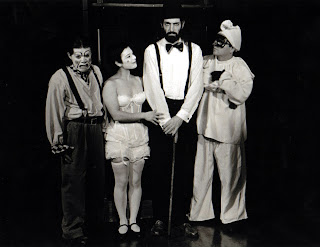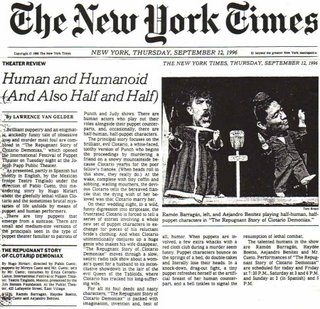
Ramón Barragán y Alejandro Benítez en The New York Times
septiembre 12, 1996
"Brilliant puppetry and an enigmatic, wickedly funny tale of obsessive love and murder most foul... The Repugnant Story of Clotario Demoniax is packed with imagination, invention, and, most of all, humor".
"Brillantes titiriteros y una enigmática y pícaramente divertida historia de amor obsesivo y alevoso asesinato... La Repugnante Historia de Clotario Demoniax está cargada de imaginación, invención, y sobre todo, humor."
Lawrence Van Gelder; The New York Times
Septiembre 12, 1996
THEATER REVIEW
Human and Humanoid (And Also Half and Half)
By LAWRENCE VAN GELDER
Published: September 12, 1996
Brilliant puppetry and an enigmatic, wickedly funny tale of obsessive love and murder most foul are combined in ''The Repugnant Story of Clotario Demoniax,'' which opened the International Festival of Puppet Theater on Tuesday night at the Joseph Papp Public Theater.
As presented, partly in Spanish but mostly in English, by the Mexican troupe Teatro Tinglado under the direction of Pablo Cueto, this meandering story by Hugo Hiriart about the gleefully lethal villain Clotario and the sometimes brutal mysteries of life unfolds by means of puppet and human performers.
There are tiny puppets that emerge from a suitcase. There are small and medium-size versions of the principals seen in the type of puppet theater familiar to patrons of Punch and Judy shows. There are human actors who play out their roles alongside their puppet counterparts, and, occasionally, there are half-human, half-puppet characters.
The principal story focuses on the brilliant, evil Clotario, a white-faced, toothy version of Punch who begins the proceedings by murdering a friend on a snowy mountainside because Clotario yearns for the poor fellow's fiancee. (When heads roll in this show, they really do.) At the wake, complete with tiny coffin and sobbing, wailing mourners, the devious Clotario tells the bereaved fiancee that the dying wish of her beloved was that Clotario marry her.
On their wedding night, in a wild, funny digression into striptease, the frustrated Clotario is forced to tell a series of stories involving a whole new set of puppet characters in exchange for pieces of his reluctant bride's clothing. And when Clotario unintentionally conjures up a huge genie who makes his wife disappear, ''The Repugnant Story of Clotario Demoniax'' moves through a slow, satiric radio talk show about a woman's quest for a husband to its inconclusive showdown in the lair of the evil Queen of the Tabloids, where Clotario has tracked his long-suffering wife.
For all its foul deeds and nasty characters, ''The Repugnant Story of Clotario Demoniax'' is packed with imagination, invention and, best of all, humor. When puppets are involved, a few extra whacks with a red cloth club during a murder seem funny. Puppet characters bounce on the springs of a bed, do double-takes and literally lose their heads. In a knock-down, drag-out fight, a tiny puppet refreshes herself at the artificial breast of her human counterpart, and a bell tinkles to signal the resumption of lethal combat.
The talented humans in the show are Ramon Barragan, Haydee Boetto, Aejandro Benitez and Mr. Cueto. Performances of ''The Repugnant Story of Clotario Demoniax'' are scheduled for today and Friday at 7:30 P.M., Saturday at 3 and 6 P.M. and Sunday at 2 (in Spanish) and 5 P.M.
THE REPUGNANT STORY OF CLOTARIO DEMONIAX
By Hugo Hiriart; directed by Pablo Cueto; puppets by Mireya Cueto and Mr. Cueto; sets by Mr. Cueto; costumes by Erica Cerdeno-Lance. International Festival of Puppet Theater. Teatro Tinglado, Mexico, presented by the Jim Henson Foundation. At the Public Theater, 425 Lafayette Street, East Village.
WITH: Ramon Barragan, Haydee Boetto, Pablo Cueto and Aejandro Benitez.
Photo: Ramon Barragan, left, and Aejandro Benitez playing half-human, half-puppet characters in ''The Repugnant Story of Clotario Demoniax.'' (Tom Brazil)

 "Sex, Violence, Greed, Lust... And They´re Only Puppets!"
"Sex, Violence, Greed, Lust... And They´re Only Puppets!"
"Sexo, violencia, codicia, lujuria... ¡y sólo son títeres!".
John Heilpern; The New York Observer; Sep., 1996


Folleto informativo del festival
 West Village, Manhattan, NY
West Village, Manhattan, NY
Fotografía: Haydeé Boetto
 Gafete
Gafete De izquierda a derecha: Jorge Boetto, Ramón Barragán, Pablo Cueto, Haydeé Boetto y Alejandro Benítez
De izquierda a derecha: Jorge Boetto, Ramón Barragán, Pablo Cueto, Haydeé Boetto y Alejandro Benítez
Camerinos del Public Theater
New York City
Septiembre, 1996

Public Theater, NYC
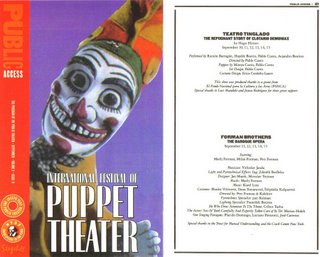 Programa de mano del festival. Cheryl Henson y Lessle Asch, organizadoras y programadoras del festival, vinieron a México a ver una función de Clotario en el teatro La capilla de Coyoacán en diciembre de 1995. La imagen del títere les gustó mucho y decidieron hacerlo la imagen del festival, estaba en programas de mano, publicidad, carteles por todo Manhattan, invitaciones, etc. Era impactante verlo por todos lados. Tuvimos la enorme fortuna de compartir créditos con muy prestigiados y reconocidos titiriteros de América y Europa: The Forman Brothers (Rep. Checa), El periférico de objetos (Argentina), Figures of Speech (EU, grupo que después nos invitó a dar funciones en Portland, Maine, en el 2004), Frantizek & Vera (Rep. Checa, con un montaje de fonógrafos, radios antigüos, títeres de madera y muchísima locura), Green Ginger (Gales. De los mejores montajes para niños que he visto: escatológico, irreverente, impresionantemente manipulado), etc.
Programa de mano del festival. Cheryl Henson y Lessle Asch, organizadoras y programadoras del festival, vinieron a México a ver una función de Clotario en el teatro La capilla de Coyoacán en diciembre de 1995. La imagen del títere les gustó mucho y decidieron hacerlo la imagen del festival, estaba en programas de mano, publicidad, carteles por todo Manhattan, invitaciones, etc. Era impactante verlo por todos lados. Tuvimos la enorme fortuna de compartir créditos con muy prestigiados y reconocidos titiriteros de América y Europa: The Forman Brothers (Rep. Checa), El periférico de objetos (Argentina), Figures of Speech (EU, grupo que después nos invitó a dar funciones en Portland, Maine, en el 2004), Frantizek & Vera (Rep. Checa, con un montaje de fonógrafos, radios antigüos, títeres de madera y muchísima locura), Green Ginger (Gales. De los mejores montajes para niños que he visto: escatológico, irreverente, impresionantemente manipulado), etc.

Todos estábamos nerviosos pero seguros de todos los ensayos previos que habíamos tenido. Ramón era el que más sufría por tener que dar las funciones en inglés, pero lo hizo como el gran actor que es. Fue una gran lección para mí acerca de cómo se trabaja a un nivel internacional, de convivencia con mis compañeros (compartimos un espacio verdaderamente reducido y poco ventilado durante tres semanas), de formas de vida en una ciudad tan llena de culturas de todo el mundo.
La Mamma Etc., New York.
Fotografía: Jorge Boetto Bárcena
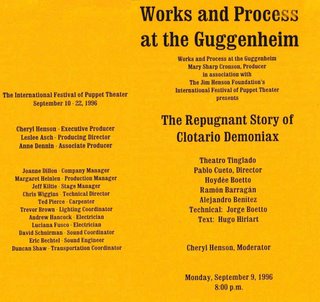
Programa de mano del programa Works and Process
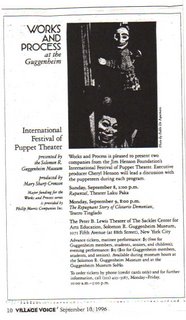 Anuncio en el periódico semanal Village Voice de la función/plática que dimos en el museo Guggenheim .
Anuncio en el periódico semanal Village Voice de la función/plática que dimos en el museo Guggenheim .
The Solomon R. Guggenheim Museum
New York City
Septiembre, 1996
Esta fue mi primera presentación en la ciudad de Nueva York. Yo no tenía la menor idea de qué era lo que nos esperaba, dónde nos íbamos a presentar, cómo reaccionaría el público, si se me olvidaría el texto en inglés, si me daría pánico escénico... nada. Al final fue maravilloso, divertido, muy emocionante y un gran éxito.








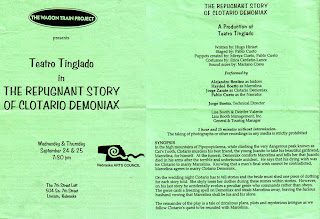






 Postal
Postal


